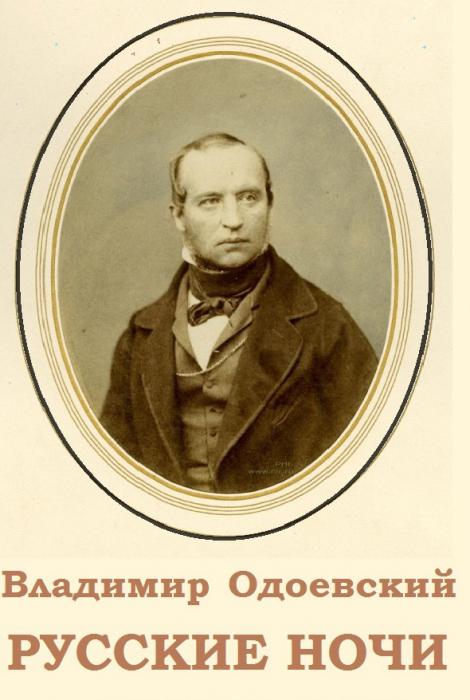The literature of the century before last has preserved for posterity many names of talented poets and writers. The works of Odoevsky - one of them - are of interest today. His tales, the utopian novel "4338: St. Petersburg Letters", the collection "Russian Nights" will be discussed in the article.
Periodization of creativity
The writer's work is conditionally divided into three periods - depending on the place where he created the works of Odoevsky. The first "Moscow" stage was marked by his participation in the circle "Society of Wisdom" and pen samples. After Odoevsky moved to Petersburg in 1826, a new period of his work began, very fruitful. The writer has published several collections of fairy tales, which are read with pleasure even now, after almost 200 years. The second “Moscow” stage is marked by the creation by Odoevsky of “Russian Nights” - his best work, as well as works on music.
"Colorful tales"
Odoevsky often built his works in cycles. Thus, creating "Colorful Tales", the writer worked simultaneously on the collection "House of Lunatics" on the theme of brilliant insanity. The tendency toward cyclization can be explained by some general processes characteristic of Russian literature of those times. Then, in the early 1930s, Belkin's Tales and Evenings on a Farm near Dikanka were published, which were nothing more than cycles. Orientation to Pushkin also determines the complex system of narration in "Colorful Tales." An abstract to the work of Odoevsky (or the preface) introduces the figure of the narrator - Irenei Modestovich Gomoseyko. In contrast to the all-encompassing Ivan Petrovich Belkin, the narrator in “Colorful Tales” has pronounced autobiographical features. Subsequently, he will try on the role of "literary double", on behalf of whom the writer will conduct a dialogue with the receiving side - the reader.
The riddle of the town in a snuffbox
In fact, the writer was a pioneer in the genre of literary tales, intended for reading primarily by a child. In 1834, almost the most famous work of Odoevsky appeared - “The Town in the Snuffbox”. The plot is simple: dad shows the boy Misha a music box-snuffbox. The son wants to find out how she works, get into it (which he, by the way, succeeds when a little man from a snuffbox beckons a boy with a finger). Misha gets acquainted with the inhabitants of the town - hammers and bells - and, waking up, understands the principle of work of the acquired little thing. For all its artistic merits, the fairy tale is interesting as a successful combination of enlightening pathos and fiction. The main idea of the work is to convince the reader that the child needs to learn to think, analyze, it is necessary to cultivate his craving for knowledge from childhood.
Russian Nights
The genre of the “Russian Nights” released in 1844 is rather difficult to identify. Often this work of Odoevsky is defined as a collection of articles of a philosophical nature. They fully reflected his ideas about transforming the world, the path that Russia should follow. Note that the publication of “Russian Nights” was preceded by the deepening of Odoevsky in the secrets of the exact sciences - mathematics, physiology and psychology, as well as philosophy.
At the same time, the writer remains faithful to the mastery of the word. Like Voltaire, he puts ideas into capacious images, hides philosophicality behind an interesting plot. This is how Odoyevsky builds works throughout his work. The plot of the collection revolves around several young people who gather at a common acquaintance called Faust. There they discuss stories, trying to understand the laws of society and penetrate the secrets of the world. The work is distinguished by intellectualism, which reaches the maximum in the descriptions of the creative process. In this case, the images created by Odoevsky fulfill the function of a meta-language: art tells about art. Thus, the Russian writer of the first half of the century before last turns out to be unexpectedly close to the later experiences of the authors of the twentieth century (referring primarily to the intellectual novels of Thomas Mann).

Dialogism of “Russian Nights” - this is what Odoevsky adhered to. The works in the collection seem to be afraid to give a final answer, to dot the i. Instead of a ready conclusion, the reader is invited to speculate, to reason. This "Russian Nights" are close to the works of other writers - Herzen and Belinsky - very unexpectedly, I must say, given the difference in their aesthetic orientation.
"4338th year" as a utopian novel
In the century before last, comet Bijela made a lot of noise. It was believed that after some time she would even collide with the surface of the Earth. Some of Odoevsky’s works reflected this “comet theme”, among them the utopian novel “4338th year: Petersburg letters”, which, unfortunately, remained incomplete. The author depicts the world after 2500 years, when the development of mankind will save the globe from a threatening comet.
The work contains features of predictive fiction and a utopian novel; the author predicts the appearance of many inventions of the future, including the Internet. However, the depicted society is not as prosperous as it seems: an ever-growing information wave does not spare human brain reserves. Utopia grows into dystopia in order to present this genre in further works (especially in the “City without a name”).